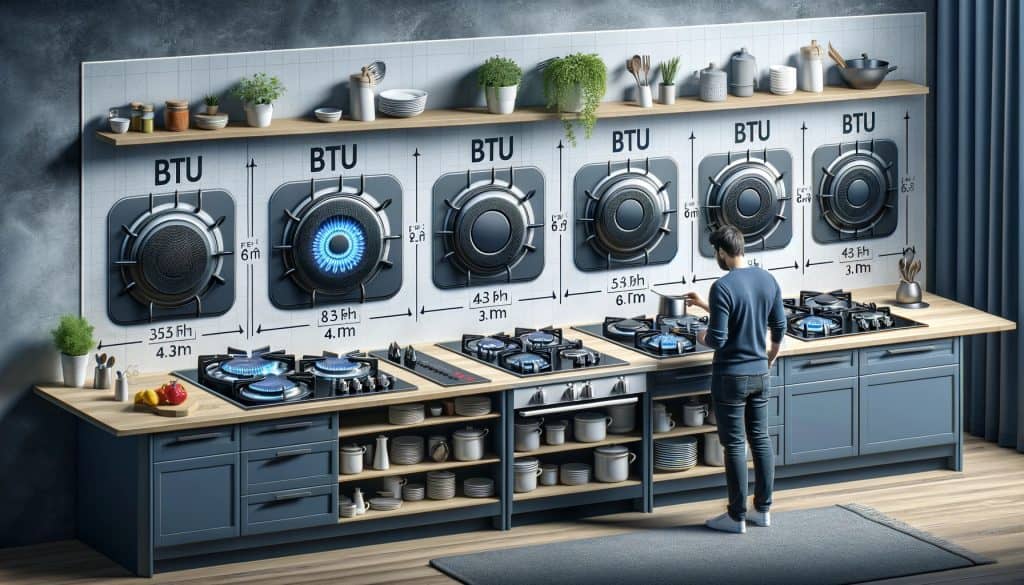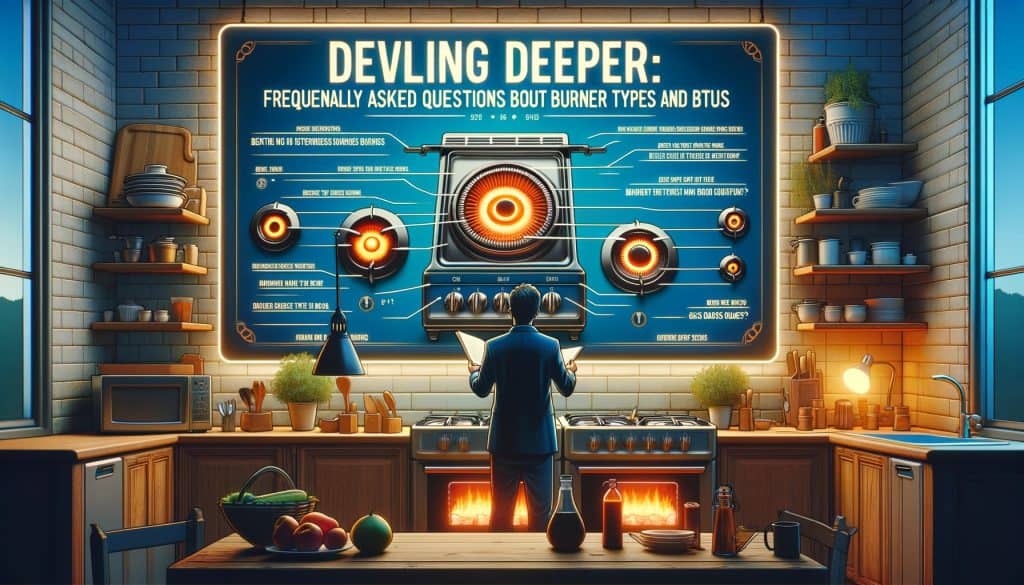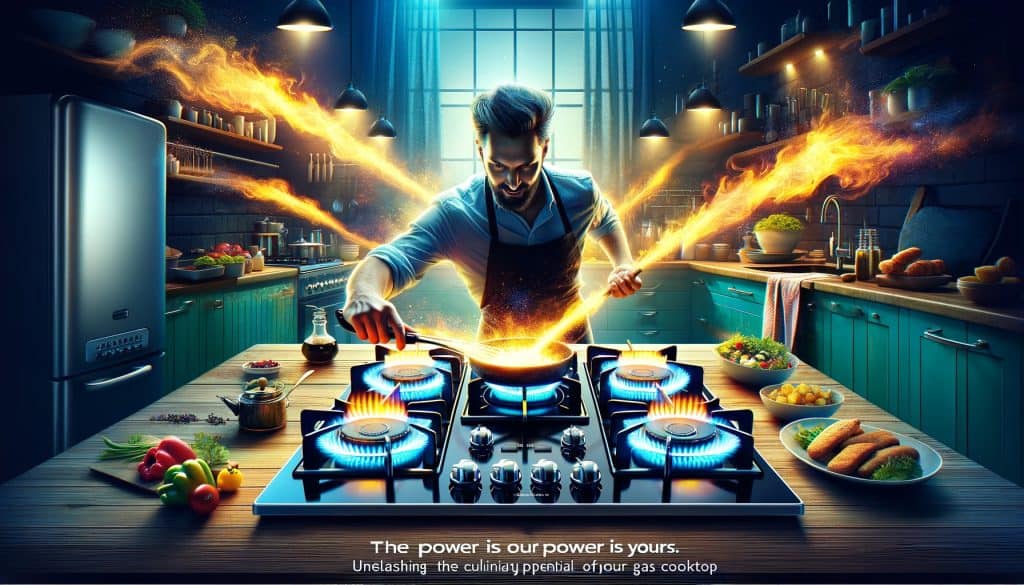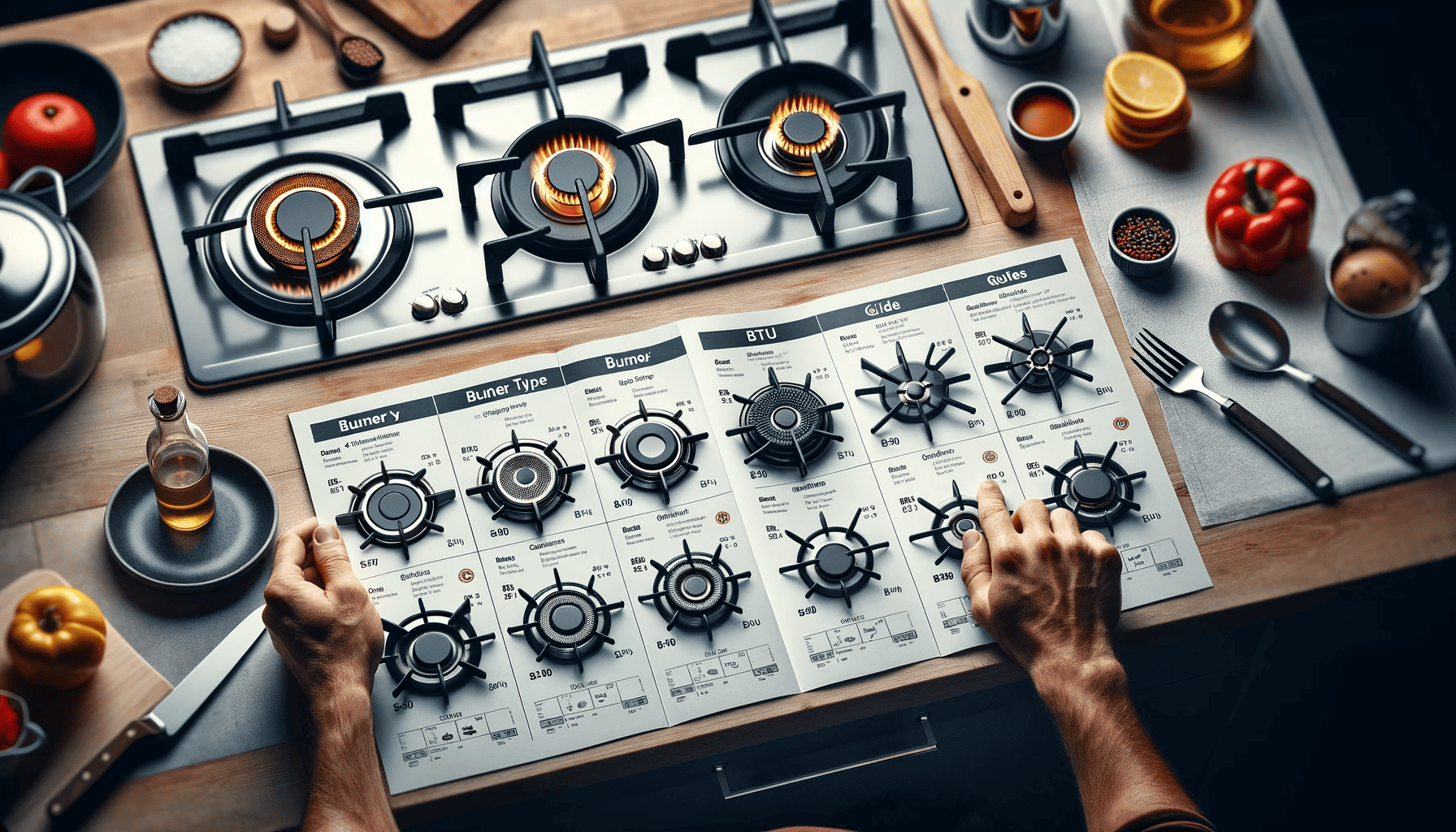The Sizzle of Success: Demystifying Gas Cooktops and Unlocking Culinary Mastery
Imagine the anticipation as you sear a succulent steak, the flames dancing and licking the edges to caramelize the crust to perfection. Or perhaps you envision the gentle simmer of a delicate sauce, the low heat coaxing out the most subtle flavors.
These culinary dreams are within your reach, but they all hinge on one key element: understanding the power of your gas cooktop.
Choosing the right burner type and BTU rating isn’t just about picking knobs and dials; it’s about unlocking a world of culinary possibilities.
It’s the difference between a bland, undercooked dish and a masterpiece that delights your senses. Just as a painter needs the right brushes and colors, so too does a chef need the right tools to create magic.
This guide will be your brushstroke in the culinary canvas. We’ll delve into the world of burner types, exploring the simmer burners that offer precise control for delicate dishes, the standard burners that handle your everyday cooking needs, and the power burners that unleash intense heat for searing and boiling.
We’ll demystify the world of BTUs, explaining how they translate to heat output and how choosing the right rating can take your cooking to the next level.
So, let’s embark on this culinary journey together. Prepare to unlock the secrets of your gas cooktop and discover the power that lies within. With the right knowledge, you’ll be cooking like a pro in no time, leaving your taste buds singing and your guests in awe.
< class="wp-block-separator has-alpha-channel-opacity"/>The Symphony of Flames: Exploring Different Burner Types
Just like an orchestra t ives on the diversity of its instruments, a gas cooktop flourishes with the variety of its burner types. Each burner, with its unique size and flame pattern, plays a distinct role in your culinary repertoire. Let’s take a closer look at these key players:

1. The Delicate Maestro: The Simmer Burner
This petite powerhouse, typically boasting a BTU rating of 500 to 2,000, is the go-to for gentle heat. Think simmering delicate sauces like hollandaise, melting butter for flaky pastries, or slowly poaching eggs for a perfectly set breakfast.
Its small size and low heat allow for precise control, preventing scorching and ensuring consistent results. With the simmer burner, you can create culinary masterpieces that require patience and finesse.
But the simmer burner’s talents extend beyond mere heat control. Its concentrated flame is ideal for small pots and pans, minimizing wasted energy and ensuring even cooking. So, whether you’re making a single serving of soup or melting chocolate for decadent desserts, the simmer burner is your loyal companion in the kitchen.
2. The Culinary Workhorse: The Standard Burner
The beating heart of most gas cooktops, the standard burner offers versatility and power. With a BTU range of 5,000 to 7,000, it tackles everyday cooking tasks with ease. Sauteing vegetables, simmering stews, or boiling water for pasta are all within its domain. Its larger size accommodates various pan sizes, making it a true all-rounder.
Beyond its everyday uses, the standard burner shines in its ability to adapt to different cooking techniques. Adjust the flame for a low simmer to infuse flavors into your broth or crank it up for a quick sear on your favorite protein.
This adaptability makes the standard burner a crucial element in any kitchen, allowing you to experiment and explore new culinary horizons.
3. The Searing Inferno: The Power Burner
For those who demand culinary firepower, the power burner stands ready. This behemoth, often boasting a BTU rating of 12,000 to 18,000, unleashes intense heat for demanding tasks.
Sear steaks to perfection, caramelize onions to a delicious sweetness, or boil a large pot of water in record time – the power burner is your answer.
But this high-powered burner demands respect.
Its intense heat can quickly scorch delicate ingredients, requiring careful attention and precise control. However, when wielded with knowledge, the power burner unlocks a world of culinary possibilities, allowing you to create restaurant-quality dishes at home.
Whether you’re searing scallops for a romantic dinner or braising a hearty stew, the power burner adds an extra dimension of flavor and texture to your creations.
< class="wp-block-separator has-alpha-channel-opacity"/>Untangling the Heat: Demystifying BTUs
BTU, or British thermal unit, might sound like an esoteric term, but it’s crucial for understanding the power of your gas cooktop.
Essentially, a BTU represents the amount of heat required to raise the temperature of one pound of water by one degree Fa enheit. Therefore, the higher the BTU rating, the more heat a burner produces.

1. BTU and Burner Size: An Intertwined Duo
BTU rating and burner size are closely linked. A large burner with a wide flame pattern typically requires a higher BTU rating to generate enough heat across its surface. Conversely, a small simmer burner needs a lower BTU rating to achieve precise control over the delicate simmering process.
Understanding this relationship helps you choose the right burner for your cooking needs. For example, if you frequently sear large cuts of meat, a high-BTU power burner is essential. But for simmering sauces or melting chocolate, a low-BTU simmer burner offers more control and prevents scorching.
2. BTU and Cooking Speed: A Race Against Time
BTU also plays a significant role in cooking speed. Higher BTU burners deliver heat more quickly, meaning you can boil water in a flash or sear a steak in minutes. This is ideal for tasks requiring fast cooking times, such as stir-frying vegetables or boiling pasta.
However, lower BTU burners offer the advantage of slower and more controlled cooking. This is perfect for delicate dishes that require gentle heat and long cooking times, such as braising meats or simmering stews. By choosing the appropriate BTU rating, you can ensure your food cooks evenly and retains its flavor and texture.
3. Beyond the Numbers: Practical BTU Applications
While BTU ratings offer valuable guidance, the key lies in understanding their practical applications. Here’s a quick guide:
- 500-2,000 BTUs: Ideal for simmering, melting, and slow cooking.
- 2,000-5,000 BTUs: Perfect for sauteing, pan-frying, and simmering larger pots.
- 5,000-7,000 BTUs: Handles everyday cooking tasks like boiling pasta, searing steaks, and stir-frying.
- 7,000-12,000 BTUs: Ideal for heavier tasks like wok cooking and deep-frying.
- 12,000+ BTUs: The high heat champion, perfect for searing thick cuts of meat, boiling large quantities of water quickly, and achieving high-heat cooking techniques.
Remember, these are just general guidelines. The optimal BTU rating for your needs ultimately depends on your cooking style and preferences. Experiment and explore different burner combinations to discover what works best for you.
< class="wp-block-separator has-alpha-channel-opacity"/>Matching the Flame to the Task: Choosing the Right Burner for Your Needs
Now that you understand the nuances of different burner types and BTU ratings, the next step is harnessing this knowledge to elevate your cooking. Choosing the right burner for your desired outcome is an art form, requiring a blend of understanding and experimentation.

1. Mastering the Simmer: Delicate Sauces and Beyond
For delicate tasks like simmering sauces, melting butter, or poaching eggs, the simmer burner reigns supreme. Its low BTU rating ensures precise control, preventing scorching and allowing flavors to develop slowly and evenly. This creates a smooth and silky texture in your sauces and perfectly cooked eggs with runny yolks.
However, the simmer burner’s versatility extends beyond its namesake. Its small size and focused flame are ideal for small pots and pans, making it perfect for reheating leftovers or preparing single servings.
It also offers efficient heat distribution, minimizing wasted energy and ensuring even cooking even in smaller cookware.
2. Everyday Hero: The Standard Burner for All-Around Cooking
The standard burner is the workhorse of the gas cooktop, tackling everyday cooking tasks with ease. Its moderate BTU range allows you to saute vegetables, simmer stews, boil water for pasta, and more, ensuring consistent results every time. Its larger size accommodates various pan sizes, making it a true all-rounder in the kitchen.
But the standard burner’s true strength lies in its adaptability. From a gentle simmer for infusing delicate flavors to a medium heat for sauteing or stir-frying, this burner adjusts to your needs seamlessly. This makes it ideal for mastering diverse cooking techniques and experimenting with new recipes.
3. Unleashing the Power: The Power Burner for Searing and Boiling
For those who demand culinary firepower, the power burner stands ready. This behemoth, often exceeding 12,000 BTUs, delivers intense heat for searing steaks to perfection, caramelizing onions for a delicious sweetness, or boiling large pots of water in record time. Its high-powered flame creates professional-grade results, elevating your cooking game to new heights.
However, wielding this powerful tool requires respect. Its intense heat can quickly scorch delicate ingredients, demanding careful attention and precise control. Experimenting with different flame settings and pan sizes is crucial to mastering this beast.
When used with knowledge, the power burner unlocks a world of possibilities, allowing you to create restaurant-quality dishes at home and impress your guests with your culinary prowess.
4. Beyond the Basics: Specialty Burners for Specific Needs
While the t ee primary burner types cover most cooking needs, some gas cooktops offer additional options:
- Wok Burners: Featuring a wider flame and higher BTU rating, these burners are ideal for stir-frying and achieving the signature wok hei flavor.
- Griddle Burners: These flat, cast iron surfaces provide even heat distribution, perfect for pancakes, grilled sandwiches, and searing meats.
- Simmer Rings: These attachments convert standard burners into simmer zones, offering precise control for delicate sauces and low-heat cooking.
By understanding the specific functions of these specialty burners, you can expand your culinary repertoire and explore new techniques, adding another layer of versatility to your gas cooktop.
< class="wp-block-separator has-alpha-channel-opacity"/>Maximizing Your Flame: Tips for Cooking Success
Now that you’ve mastered the fundamentals of burner types and BTU ratings, let’s delve into the art of maximizing their potential for culinary success. By incorporating these tips into your cooking routine, you’ll unlock a world of flavor and efficiency.

1. Choosing the Right Cookware:
The cookware you choose plays a crucial role in how heat distributes across the burner surface. Opt for flat-bottomed pots and pans that match the burner size for optimal contact and even cooking. Avoid using warped or damaged cookware, as these can create uneven heating and lead to burnt spots.
Choosing the right material is equally important. For searing and high-heat cooking, cast iron or stainless steel are ideal choices.
For delicate sauces and simmering, copper or aluminum offer superior heat conductivity and control. By matching your cookware to the burner type and cooking task, you’ll achieve consistent results and prevent overheating or scorching.
2. Mastering the Flame:
The key to unlocking the full potential of your gas cooktop lies in understanding flame control. Learn to adjust the flame size and intensity to match your specific cooking needs. A lower flame is perfect for simmering and slow cooking, while a higher flame is ideal for searing, sauteing, and boiling.
Experimenting with different flame settings is crucial for mastering diverse techniques. For even heat distribution, move the pan around the burner occasionally, ensuring all ingredients cook evenly.
By understanding how to control the flame, you’ll achieve optimal results and prevent overcooking or undercooking your food.
3. Utilizing Burner Combinations:
Most gas cooktops offer multiple burner types, allowing you to create a “cooking zone” tailored to your specific needs.
For instance, use a power burner for searing meat, while simultaneously simmering a sauce on a neighboring simmer burner. This multitasking approach saves time and allows you to cook multiple dishes at once.
Additionally, consider utilizing burner size and BTU differences to create temperature gradients within your cooking zone. For example, use a larger burner with a higher BTU rating on one side and a smaller burner with a lower BTU rating on the other.
This allows you to saute vegetables on the hotter side while gently simmering a sauce on the cooler side, maximizing your cooking space and efficiency.
4. Maintaining Your Cooktop:
Regularly cleaning and maintaining your gas cooktop is essential for optimal performance and longevity. Spills and splatters can clog burner ports and affect flame distribution. Wipe down your cooktop after each use with a damp cloth and mild soap.
For deeper cleaning, follow the manufacturer’s instructions to remove burner caps and grates for thorough scrubbing.
Investing in a cooktop cleaner and scraper can help remove stubborn stains and burnt-on food particles. Additionally, avoid using harsh chemicals or abrasive cleaners, as these can damage the cooktop surface.
By maintaining your cooktop properly, you’ll ensure its continued efficiency and prevent potential issues.
By adhering to these tips and experimenting with different combinations, you’ll master the art of gas cooktop cooking and unlock a world of culinary possibilities.
Remember, the key lies in understanding your burners, learning to control the flame, and choosing the right cookware for the task at hand. With dedication and practice, you’ll soon be creating restaurant-quality dishes in the comfort of your own kitchen.
< class="wp-block-separator has-alpha-channel-opacity"/>Delving Deeper: Frequently Asked Questions About Burner Types and BTUs
As you embark on your journey to mastering gas cooktop cooking, you may encounter questions that pique your curiosity. This section addresses some frequently asked questions about burner types and BTUs to further expand your understanding and unlock new culinary possibilities.

1. What is the best burner type for searing steaks?
For searing steaks to perfection, a high-BTU power burner is your best friend. Its intense heat quickly creates a caramelized crust, locking in the juices and flavor of the meat. Aim for a burner with a BTU rating exceeding 12,000 for optimal searing results.
2. What is the best burner type for simmering sauces?
The delicate nature of simmering sauces demands precise control. A low-BTU simmer burner, typically ranging between 500 and 2,000 BTUs, is ideal for this task. Its concentrated flame provides gentle heat, preventing scorching and ensuring even cooking.
3. Can I use a wok on a standard burner?
While technically possible, using a wok on a standard burner isn’t ideal. The wok’s rounded bottom doesn’t make full contact with the flat surface of the burner, leading to uneven heat distribution and potential scorching.
For optimal wok cooking, investing in a dedicated wok burner with a wider flame and higher BTU rating is recommended.
4. What is the best BTU rating for boiling water quickly?
For the fastest boiling times, choose a burner with a high BTU rating, ideally exceeding 10,000. This ensures rapid heat transfer to the water, boiling it in a matter of minutes. Remember that the size of your pot also plays a role; larger pots require higher BTU ratings for efficient boiling.
5. How can I maintain consistent heat while sauteing?
Maintaining consistent heat while sauteing is crucial for achieving even cooking results. Utilize a medium-BTU standard burner, typically ranging between 5,000 and 7,000 BTUs. Adjust the flame size as needed to maintain the desired temperature and prevent overcooking or undercooking your ingredients.
6. Is it safe to use a simmer burner for high-heat cooking?
While technically possible, using a simmer burner for high-heat cooking isn’t recommended. These burners aren’t designed to handle the intense heat required for tasks like searing or stir-frying. Doing so can damage the burner and lead to safety hazards.
By understanding the answers to these frequently asked questions, you’ll be able to navigate the world of gas cooktop cooking with confidence and knowledge.
Remember, experimentation is key to discovering what works best for you and your culinary preferences. So, don’t be afraid to explore different burner combinations and techniques to unlock the full potential of your gas cooktop.
< class="wp-block-separator has-alpha-channel-opacity"/>The Power Is Yours: Unleashing the Culinary Potential of Your Gas Cooktop
By comprehending the symphony of burner types, demystifying the language of BTUs, and mastering the art of flame control, you’ve unlocked the door to a world of culinary possibilities.

From the gentle simmer of delicate sauces on the simmer burner to the searing intensity of a power burner caramelizing a juicy steak, your gas cooktop becomes an extension of your creativity. You can tailor your cooking to your needs, whether it’s simmering a fragrant curry for hours on end or quickly boiling pasta for a weeknight meal.
Remember, experimentation is key. Explore different burner combinations, adjust flame sizes with confidence, and choose the right cookware for the task at hand. By embracing the versatility of your gas cooktop, you’ll soon be creating restaurant-quality dishes and impressing your loved ones with your culinary prowess.
So, ignite your passion, unleash the power of your gas cooktop, and embark on a journey of culinary discovery. With each flame, you’ll unlock new flavors, techniques, and the joy of creating delicious memories that will last a lifetime.


